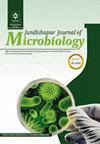Immunologic Profile of Severe COVID-19 Patients in Alborz Province, Iran
IF 0.5
4区 医学
Q4 MICROBIOLOGY
引用次数: 0
Abstract
Background: The coronavirus disease 2019 (COVID-19) pandemic has prompted researchers to look for severe acute respiratory syndrome coronavirus 2 (SARS-CoV-2) pathogenicity in depth. Immune system dysregulation was one of the major mechanisms in its pathogenesis. The evidence regarding the levels of interferons (IFNs) and pro- and anti-inflammatory cytokines in COVID-19 patients is not well-established. Objectives: Therefore, this study evaluated the expression level of type-I, II, III IFNs, along with interleukin-1 (IL-1), interleukin-6 (IL-6), interleukin-10 (IL-10), and FOXP3 genes in patients with severe COVID-19 to provide additional insights regarding the regulation of these cytokines during COVID-19 infection. Methods: Peripheral blood mononuclear cells were isolated from two groups, including severe COVID-19 patients and healthy controls. Ribonucleic acid was extracted to evaluate the expression level of IFN-a, IFN-b, IFN-g, IFN-la, IL-1, IL-6, IL-10, and FOXP3 genes using real-time polymerase chain reaction. The correlations between the expression levels of these genes were also assessed. Results: A total of 40 samples were divided into two groups, with each group consisting of 20 samples. When comparing the severe COVID-19 group to the controls, the expression levels of IFN-g, tumor necrosis factor-alpha (TNF-α), IL-6, and IL-10 genes were significantly higher in the severe COVID-19 group. The two groups had no significant differences in IFN-a, IFN-b, IFN-la, IL-1, and FOXP3 expression. The correlation analysis revealed a negative correlation between type I and type III IFNs (i.e., IFN-a and IFN-la) and pro-inflammatory cytokines (i.e., IL-1 and IL-10). Conclusions: This study suggests the possible upregulation of IFN-g, IL-6, IL-10, and TNF-α during SARS-CoV-2 pathogenicity. The preliminary findings of this study and those reported previously show that the levels of IFNs and pro- and anti-inflammatory cytokines are not uniformly expressed among all COVID-19 patients and might differ as the disease progresses to the severe stage.伊朗阿尔布尔茨省新冠肺炎重症患者免疫概况
背景:2019冠状病毒病(新冠肺炎)大流行促使研究人员深入寻找严重急性呼吸综合征冠状病毒2(SARS-CoV-2)的致病性。免疫系统失调是其发病机制之一。关于新冠肺炎患者中干扰素(IFN)、促炎和抗炎细胞因子水平的证据尚不明确。目的:因此,本研究评估了重症新冠肺炎患者中I型、II型、III型IFN以及白细胞介素-1(IL-1)、白细胞介素-6(IL-6)、白介素-10(IL-10)和FOXP3基因的表达水平,以提供有关这些细胞因子在新冠肺炎感染期间的调节的更多见解。方法:从新冠肺炎重症患者和健康对照组中分离外周血单核细胞。提取核糖核酸,使用实时聚合酶链反应评估IFN-a、IFN-b、IFN-g、IFN-la、IL-1、IL-6、IL-10和FOXP3基因的表达水平。还评估了这些基因的表达水平之间的相关性。结果:将40份样本分为两组,每组20份。当将重症新冠肺炎组与对照组进行比较时,重症新冠肺炎组IFN-g、肿瘤坏死因子α(TNF-α)、IL-6和IL-10基因的表达水平显著升高。两组在IFN-a、IFN-b、IFN-la、IL-1和FOXP3表达方面没有显著差异。相关性分析显示,I型和III型IFN(即IFN-a和IFN-la)与促炎细胞因子(即IL-1和IL-10)之间呈负相关。结论:本研究提示IFN-g、IL-6、IL-10和TNF-α在严重急性呼吸系统综合征冠状病毒2型致病过程中可能上调。这项研究的初步结果和之前报道的结果表明,在所有新冠肺炎患者中,IFN以及促炎和抗炎细胞因子的水平并不一致,并且可能随着疾病发展到严重阶段而有所不同。
本文章由计算机程序翻译,如有差异,请以英文原文为准。
求助全文
约1分钟内获得全文
求助全文
来源期刊

Jundishapur Journal of Microbiology
MICROBIOLOGY-
CiteScore
1.30
自引率
0.00%
发文量
56
审稿时长
6-12 weeks
期刊介绍:
Jundishapur Journal of Microbiology, (JJM) is the official scientific Monthly publication of Ahvaz Jundishapur University of Medical Sciences. JJM is dedicated to the publication of manuscripts on topics concerning all aspects of microbiology. The topics include medical, veterinary and environmental microbiology, molecular investigations and infectious diseases. Aspects of immunology and epidemiology of infectious diseases are also considered.
 求助内容:
求助内容: 应助结果提醒方式:
应助结果提醒方式:


